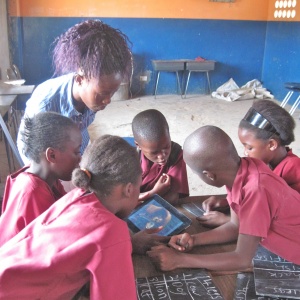OER4Schools/activities/Same-task and different-tasks group work
| Resource details | |
| Title | Same task and different tasks group work |
| Topic | |
| Teaching approach | |
| Learning Objectives | |
| Format / structure | |
| Subject | |
| Age of students / grade | |
| Table of contents | |
| Additional Resources/material needed | |
| Useful information | |
| Related ORBIT Wiki Resources | |
| Other (e.g. time frame) | |
| Files and resources to view and download | |
| Acknowledgement | This resource is part of the OER4Schools programme. |
| License | |
![]() Individual activity (5 min): Read the background text on same task group work and different tasks group work.
Individual activity (5 min): Read the background text on same task group work and different tasks group work.
'Same task group work' and 'different task group work' are important concepts in interactive teaching.
Same task group work involves assigning the same problem to each group. Each group’s presentation provides a different perspective/way of solving the problem. For example,
- “A farmer has a plot of land of size 30 metres x 20 metres. He has to plant 60 trees and 20 shrubs. Which pattern of planting would you suggest to the farmer? Why? Consider that the shrubs should not be shadowed by the trees so that they get light.”
- “New classrooms are being built for grades one and two in another rural area.Tables and chairs are needed for these classrooms. Give suggestions about the size and shape of the tables and chairs to the headmaster. Each group can give one suggestion for a table and a chair. Explain your suggestions with reasons.”
Different tasks group work involves assigning different aspects of the same problem to each group. Each group’s presentation is like a piece of the jigsaw that completes the whole picture. For example,
- “The Zambian health minister has asked you to make handouts/pamphlets about diseases. The pamphlets will be distributed in hospitals to inform people about prevention of diseases. The diseases for which handouts are needed are: (a) Tuberculosis; (b) Malaria and (c) HIV/AIDS. Three groups will work on the different diseases. In your group, consider which information you want to include and why.”
- “The local environment committee has observed that pollution is increasing in your area. They have asked you to find out the reasons for increasing pollution and suggest ways to decrease it. Prepare a presentation for different types of pollution: (a) air pollution, (b) water pollution, (c) noise pollution and (d) soil pollution.”
![]() Whole class dialogue (10 min): Discussion on group work. Discuss:
Whole class dialogue (10 min): Discussion on group work. Discuss:
- What are your general observations about questions for group work?
- How are the questions for same task group work different from different tasks group work? What is the advantage of setting different tasks to groups?
- Suggest a topic that you could teach through same task group work.
- Suggest topics that you could teach through different tasks group work.
Reinforce that questions for group work are more motivating when presented as real life problems. Also presentations are more interesting to hear when they are all focused on a different question.
Then highlight the important aspects of the problem that groups should consider. This increases the challenge for the group work.Carry out the last two bullet points (about topics) like a brainstorm. Record the answers on a flip chart or blackboard so that participants can see them during the 3rd Activity. You could ask a volunteer to write them.


